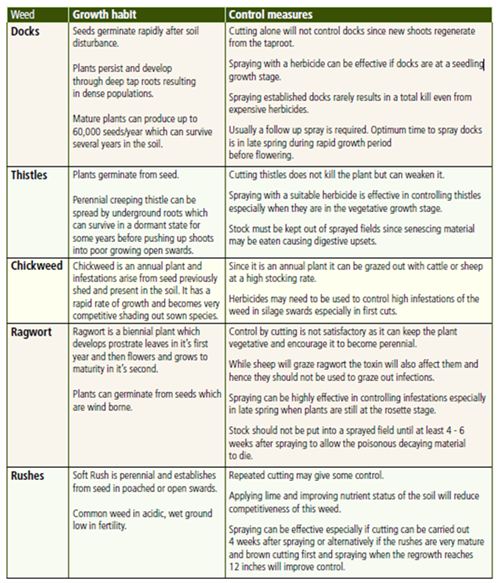



How to Control Grassland Weeds
Controlling grassland weeds such as ragwort, thistles and docks remains a priority, with new industry figures showing that, at its worst, Chickweed can reduce silage yields by 65 per cent.This month, UK levy board DairyCo has said that Grassland weeds, particularly when they reach density levels of 10-20 per cent in swards, will have a significant effect on sward production.
There is a direct correlation between dock and spear thistle ground cover and grass yield every 1 per cent increase in ground cover results in a 1 per cent decrease in grass growth, according to DairyCo Research and Development Manager, Dr Debbie McConnell.
In addition, although some weeds have a small amount of nutritional value, digestibility is much lower than perennial ryegrass and the structure of the weed can discourage stock from grazing surrounding grass. To effectively control grassland weeds it is first important to understand what species are present and their individual growth habit.
Grassland weed species
There are a variety of weed species that can appear in grassland. Some of the most commonly found species and their growth habit are listed in Table 1 below, however, more detailed information can be found here.
Annuals
When establishing new leys annual weeds are the most common problem and a wide range of species can appear. However, most of these fade away once the sward has been cut and the density of the sward starts to increase. Common chickweed is an exception to this rule and can appear in established grasslands where there are bare patches of soil.
Biennial weeds
Biennial weeds, such as ragwort and spear thistle, could have a significant impact on grass productivity particularly in rotational leys. The plants germinate and produce vegetative growth in the first season and them flower and die in the second.
Perennial weeds
Many perennial weeds exist in grassland and can have long term implications for sward productivity. Perennials, such as creeping thistle, butter cups and docks, can appear in a variety of ways in the sward. They may survive as rhizomes or roots in the soil during reseeding and consequently appear in the new ley. Disturbing the seed bank at reseeding can also encourage new weeds to generate.
Probably the most common way of entering a sward is through exploiting gaps in the sward (eg areas of poor growth or bare soil) and germinating. Arguably, docks are one of the most detrimental weeds in the grassland sector and consequently the Weeds Act 1959, requires that land owners control areas of significant dock infestation.
Docks produce a large number of wind transmitted seeds which can generate at any stage throughout the growing season. In addition, the plant has a large tap root and rapid growth response to nutrient inputs, an ability to grow in low light conditions and a resilience to trampling from animals, all fuelling its competitiveness in grassland swards.
The seed is incredibly resilient (lasting over 25 years) and can be passed through the gut of the animal, stored in slurries and reapplied to land where is can germinate. As a result, docks can rarely be removed by one treatment event, rather setting out a plan for the season to managing your weed control is advisable.
Controlling weeds
As weeds increase in size they become more difficult to control so having strategies in place to ‘nip it in the bud’ early on is advisable. This can be done easily on the grazing rotation through spot spraying as soon as the cows have finished grazing each individual paddock. In doing so, weeds are easier to spot, are likely to be actively growing (encouraging uptake of the herbicide), herbicide is used efficiently and it also gives a good excuse to re-evaluate your residuals.
Good grassland management and a knowledge of the growth habit of individual weeds (Table 1) can go a long way to reducing the weed burden. Management practices which encourage a dense competitive grass sward will reduce the risk of weed infestation, as for many seeds, the absence of light via a densely packed grass sward will stop them from germinating.
Practices such as maintaining soil fertility, grazing, topping, mowing and drainage will all help reduce weed burden and are particularly effective in situations where herbicides will not work, for example, with unproductive perennial grasses such as couch or creeping soft-grass.



